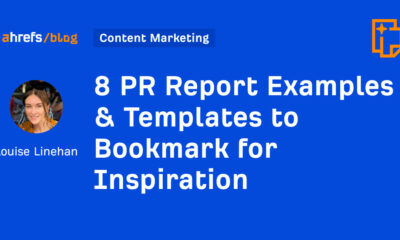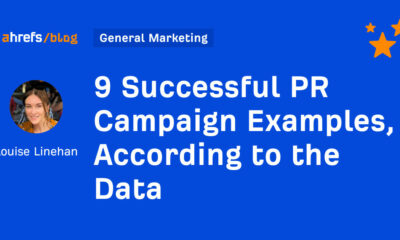MARKETING
How Nonprofits Can Use TikTok for Growth [Case Study + Examples]
![How Nonprofits Can Use TikTok for Growth [Case Study + Examples] How Nonprofits Can Use TikTok for Growth [Case Study + Examples]](https://articles.entireweb.com/wp-content/uploads/2022/03/How-Nonprofits-Can-Use-TikTok-for-Growth-Case-Study.jpgkeepProtocol.jpeg)
TikTok has shaken up the digital landscape — and its explosive growth over the past year suggests that it’s here to stay.
Although it’s an entertainment-first platform, TikTok is more than just Gen Z dance challenges.
We’re seeing more and more social impact and non-profit clients use TikTok to inform, educate, engage, advertise, and raise funds and awareness.
Here, let’s explore tips and best practices for nonprofits looking to leverage TikTok for growth.
Is TikTok right for your nonprofit?
Building a presence on a new social media platform can be a big undertaking. As with any platform, it’s essential to assess whether it’s a good fit for your organization, and whether it will help you meet your goals.
Before diving in, it’s important to ensure that your efforts go into spaces and platforms that your audience already uses.
First, make sure TikTok helps reach your organization’s target audience. Remember: over 50% of the apps’ users are under 32 years old, and over 41% of TikTok users are between the ages of 16 and 24, according to Qgiv.
You’ll also want to assess whether your organization can manage a TikTok channel. If you’re considering whether your organization has the capacity to build a TikTok presence, the first step is to ask — and trust — the person or team who manages your social media.
Another thing to consider is the way TikTok prioritizes raw, real, unedited, and people-first videos. On this platform, link posts or polished graphics and copy won’t cut it. Think about whether you have employees willing to make videos for the account, or if you have the budget to hire creators and influencers to build your presence.
Having an employee kick off your TikTok account is a great starting point, but it’s not the only way. TikTok’s creator marketplace is the platform’s official collaboration center that connects brands and creators to execute paid and reward-based campaigns. This is a great starting point for nonprofit’s that are new to TikTok.
8 Tips + Best Practices for Nonprofits on TikTok [+ Examples]
Once you’ve determined TikTok will help you reach your goals and target audience, and you’ve ensured you have the resources to manage the platform, it’s time to get into some tips that can help nonprofits move missions forward with quality TikTok content.
1. Creative is the primary factor for success.
Your content is everything on this platform. As noted above, polished photos and videos won’t cut it. You need a real person (whether that be an employee or creator from TikTok’s Creator Marketplace) to commit to making videos that have high-performing elements.
2. Use the principle of “entertainment-first”.
Remember that TikTok is an entertainment platform first and foremost.
The American Kennel Club (AKC) uses Facebook to share tips and articles about dog care — like this post featuring the best dog raincoats — to establish its place as an expert in dog welfare.
AKC’s TikTok, however, has a different goal: to engage audiences with cute dog videos. This TikTok post succeeded not by educating about dog care, but by showing off the incredibly cute Pekingese breed at a dog show.
3. Leverage talent to bring your videos to life.
More than one in three viral videos featured a person speaking within the first three seconds, according to a recent analysis of over 600 viral TikTok videos by SemRush. Featuring actual people in your video content is essential, and it gives your organization the chance to spotlight and uplift a diverse group of voices.
There are a few key places you can source talent from — for instance, consider inviting folks from different departments of your organization to create or star in content, or tap into the platform’s vast supply of creators.
The It Gets Better Project taps into a network of creators that they have established relationships with — like this video featuring Zoe Stoller — to create fun, informative content for their page.
4. Stay ahead of trends and find inspiring creations from the Discover page.
Trends are constantly circulating on TikTok, and the best way to know which content, audio, hashtags, or concepts are going viral on the platform is to engage with the Discover page. Think of this page as the hub for the most popular content on the app. This space also includes featured placement for paid media.
On the Discover page, you’ll see a series of trending hashtags that you can click through. The set of videos that appear under each hashtag are videos that either started the trend or popular videos that are relevant to the trending hashtag.
It’s a good idea to use these examples as inspiration when developing new videos, but a TikTok strategy should not focus solely on reacting to viral trends.
5. Approach TikTok like a regular human — not a brand.
Establishing your organization’s identity or persona is critical when building a content strategy because this is the first step in attracting an engaged audience.
As noted earlier, Gen Z — a primary audience on this app — favors authenticity more than their millennial counterparts. Instead of trying to appeal to a massive audience, lean into your organization’s unique knowledge base and informative storytelling.
If you aren’t sure how to build a TikTok persona for your organization, start with your mission statement! From there, you can narrow down which content buckets you would like to focus on, and ultimately the type of videos you want to make.
AKC posted this video of a dog competing in an agility contest — and despite being filmed on a smartphone, the TikTok earned over 2 million views. Expensive equipment is not necessary to produce highly engaging content.
6. Use a story arc.
Videos should have a concise beginning, middle, and end. Consider mapping out key story fundamentals such as a hook, introduction, interesting turn, and final pay-off before executing a TikTok. Storyboarding can help to streamline the filming process, and it provides guidelines for those who are new at creating this sort of content.
In preparation for It Gets Better Project’s organic TikTok campaign promoting the “50 States. 50 Grants. 5000 Voices.” grant program, the Media Cause team developed a narrative structure and sample script to correspond with the campaign’s branded hashtag.
Mapping out a sample narrative arc and example script was important to illustrate how the overarching campaign would function on the platform. It also served as a useful tool to share with talent who would eventually participate in the creating content for the TikTok campaign.
Media Cause partnered with the TikTok team to gain feedback on the narrative arc and branded hashtag — and, as a result, It Gets Better Project’s campaign was featured on the TikTok Explore page.
7. Keep it concise (15-30 seconds), and get to the point.
Be sure to show your followers the lesson or purpose of the video within the first three seconds … That’s all the time you get before the average user swipes.
You can easily achieve a captivating introduction by using text on the screen, narration, or front-loading the video with the most salient information.
Consider, for instance, this Natural Resource Defense Council (NRDC) TikTok video, which educates viewers on the infrastructure package in a mere 30 seconds:
8. Inspire co-creation.
When crafting a content strategy, you don’t need to start from scratch. Leverage in-app tools to promote conversation and engagement with existing audiences that overlap with your own — this can be through TikTok’s duet, react, reply with video, and stitch features.
Inspire your audience to have a dialogue with your organization through the use of polls or Q&As. Also, community management is key on TikTok, so be sure to answer any questions you receive in your comments (or in the comment section of other viral TikToks).
Ultimately, TikTok is here to stay, and it provides the opportunity to connect with an audience you may not otherwise reach. As with any platform, it’s essential to assess whether it’s a good fit for your organization and goals.
Once you’ve determined whether a TikTok strategy will help your organization reach its desired audience and goals, embrace these tips to ensure success. Remember: Experimentation and creativity are key! The time and energy you invest in this platform to gain brand awareness could lead to audience loyalty and high-quality conversions.
Media Cause’s Patricia Camerota (Social Media Strategist) and Janine Guarino (Associate Social Director) contributed to this post.
Source link

![How Nonprofits Can Use TikTok for Growth [Case Study + Examples] nonprofit trends](https://articles.entireweb.com/wp-content/uploads/2022/03/1647908718_163_How-Nonprofits-Can-Use-TikTok-for-Growth-Case-Study.png)










![Holistic Marketing Strategies That Drive Revenue [SaaS Case Study] Holistic Marketing Strategies That Drive Revenue [SaaS Case Study]](https://articles.entireweb.com/wp-content/uploads/2024/09/Holistic-Marketing-Strategies-That-Drive-Revenue-SaaS-Case-Study-400x240.png)
![Holistic Marketing Strategies That Drive Revenue [SaaS Case Study] Holistic Marketing Strategies That Drive Revenue [SaaS Case Study]](https://articles.entireweb.com/wp-content/uploads/2024/09/Holistic-Marketing-Strategies-That-Drive-Revenue-SaaS-Case-Study-80x80.png)
You must be logged in to post a comment Login